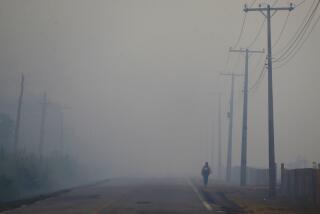Brazil Tries to Stop Slash-and-Burn Destruction of Rich Amazon Forests
- Share via
PORTO VELHO, BRAZIL — Here in the state of Rondonia on the southern flank of the great Amazon rain forest, a new frontier opened up in the late 1970s. Encouraged for a decade by the Brazilian government, hundreds of thousands of settlers came to help push back the wilderness and share the bounty. Rondonia was the land of opportunity, the Golden West of Brazil.
Now the heady frontier spirit has faded and a new realism seems to be setting in.
Slash-and-burn farming and ranching has stripped away as much as one-third of the forest that once protected Rondonia’s soil from the baking sun and leaching rains. The state’s jungle Indian population has dwindled from 40,000 to 5,000, according to a study by Brazilian anthropologist Cecilia Meireles.
Small farmers who thought Rondonia promised an escape from poverty have failed to improve their lot. Malaria is a frequent visitor at makeshift rural homes. Porto Velho, the state capital, is crowded with slum dwellers who gave up on the land. Although the government spent hundreds of millions of dollars on a frontier development program called Polonoroeste, farmers have received little technical or financial aid. More than half the land they have cleared is uncultivated and has given way to a matted growth of secondary brush called capoeira.
Like other areas on the Amazon frontier, Rondonia obviously hasn’t turned out the way it was supposed to. Officials here don’t need foreign conservationists to tell them that, but in the past year, European and American worries about destruction of the Amazon forest have poured down on Brazil like tropical rain. Perhaps because of the international pressure, perhaps because it makes sense, Brazilian authorities are adopting new policies aimed at slowing the destruction. Some conservationists are skeptical about the effectiveness of the policies, but at least on paper, preservation is becoming the new official watchword in the Amazon region of Brazil.
President Jose Sarney has announced a series of protective measures in a program called “Our Nature.” One new decree suspends official credits and tax breaks that had encouraged cattle ranchers to turn forest into pasture. The program also includes a zoning study that would put huge forest areas off-limits to ranchers, farmers, loggers and miners.
The Rondonia state government already has its own zoning plan. Approved last June, it limits agricultural activities largely to central and southern areas of the state where most deforestation has taken place and where soils are richest.
Vice Gov. Orestes Muniz, also Rondonia’s planning secretary, says that by recovering millions of acres gone to capoeira, the state can save vast areas of virgin forest from the wasteful slash-and-burn cycle. Technicians are also experimenting with the use of capoeira as cover for crops that require shade, such as coffee and fruit trees.
Muniz said the zoning plan sets aside about 60% of the state’s territory as natural preserves. To enforce protective measures, the state police force has created a forest patrol unit that now employs 350 officers and eventually will have 1,000. A freeze on all deforestation is in effect, pending implementation of the plan. Thirty percent of the state is designated as extractive reserves and managed forests, where rubber, Brazil nuts, medicinal plants and selected hardwoods and other products can be harvested without deforestation. Officials say the potential for economic returns is great. Rondonia woodlands contain an estimated 40,000 plant species, only about a tenth of which have been classified and studied. Another 30% of preserved forest area includes natural parks and Indian lands.
To implement the plan, the state is starting a program called Planafloro, with projects for education, technical aid and financing to help people to preserve the forest while exploiting its riches.
“To the extent that the small producer gets income from the standing forest, he will not cut more down,” said Teodorico Rocha, a federal official helping on the Planafloro.
Planafloro will cost an estimated $213 million, and the national government is negotiating for a loan from the World Bank to cover part of the cost. Rocha said it is “absurd” for Brazil to increase the heavy burden of its $115 billion foreign debt, but the country cannot afford to pay for the conservation program by itself.
“There is consciousness for preserving the environment in Rondonia,” he said. “What is lacking are the means, financing.”
In an emotional speech this month, President Sarney appealed to foreigners who accuse Brazil of destroying the Amazon to help provide the means for preserving it.
“Transfer technology to us without costs,” Sarney said. “Help us to combat the burning with airplanes, with equipment, with products. Help us to reforest with material, scientific and human resources.”
Foreign aid alone cannot prevent further destruction in the Amazon by economic interests and ignorance, but Brazilians who want to save the forest need all the help they can get.
More to Read
Sign up for Essential California
The most important California stories and recommendations in your inbox every morning.
You may occasionally receive promotional content from the Los Angeles Times.










